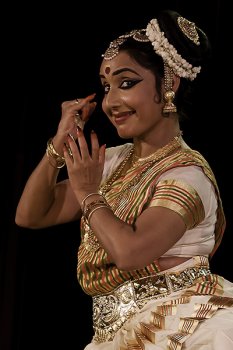
|   |

|   |
Scintillating lasya evoking the arangam Text & pic: Hareesh N. Nampoothiri e-mail: newn.haree@gmail.com January 7, 2014 The stage was well set, lights were on and the fragrance of frankincense filled the air – it was yet another performance evening at the Rukmini arangam of Kalakshetra. The evening was dedicated for two art forms from Keralam - a Sopana music concert followed by a Mohiniattam recital. Ambalappuzha Vijayakumar followed the 'Kottippadiseva' (the traditional way of rendering songs near the shrine) style of rendering which brought in the true flavor of Sopana sangeetham, thus creating a serene atmosphere perfect for the dance recital to follow.  Mohiniattam dancer Dr. Neena Prasad is known for her abilities to bring in novelties without muddling the framework of traditional Mohiniattam repertoire. The performance here was yet another testimony to this. A short but brisk Cholkettu combined with a Ganesa Sthuthi (Reethigowla / chaturasra jaati ata) was the opening piece. Swathi Thirunal’s second Utsava Prabandham “Pankajakshanam Ramesan...” (Todi / rupaka) followed. Neena elaborated the procession carrying the idol of Padmanabha and the way she brought in the concept of ‘abalavrudham’ (meaning: from children to old) while showing the people trying to get a glimpse of Lord Padmanabha was impressive. Madhavi of ‘Silappadikaram’ was the heroine of the pada varnam, originally composed and choreographed by her guru Kalamandalam Sugandhi. Self confident and sensuous Madhavi introduces herself as the ‘Nadanalathika Madhavi’ in the earlier segment. Then in the latter part she expresses her profound love towards Kovalan and says she is all for him. Madhavi is seen in two disparate emotional states in this varnam and Neena ably made the difference felt. Jayadeva’s ashtapadi, “Rathisukhasare...” (Ragamalika / Talamalika) followed. Sakhi sending Radha to the breezy banks of Yamuna to meet Krishna being the theme, Neena's presentation brimmed with emotional ardor. The fluency in her abhinaya kept the audience engaged throughout the narratives. When it comes to the choreography set to the chollus, swaras and jathis, she blended some swiftly paced footwork as well into the characteristic lasya movements of the dance form. The uniqueness was evident in the thillana set in Amritavarshini / adi which was then followed by a mangalam concluding the recital. The music ensemble led by the vocalist Chenganasseri Madhavan Namboothiri, supplemented the dancer in every possible way. Be it the Swathi krithi in Todi or the pada varnam in Surutti, Madhavan Namboothiri was at his best. T.N. Saranya (talam), Ganesh Babu (mridangam), Vijesh (violin), Murali Krishna (veena) and Krishnakumar Thrissur (edakka) were the other members in the team. The sound engineers also deserve credit here for rightly mixing the channels making it pleasant to the ears. The event was organized on Dec 28, 2013 by Kalakshetra, Chennai, as part of their 61st Annual Art Festival. Hareesh N Nampoothiri is a visual design consultant by profession and a lover of classical art forms. Being an ardent follower of Kathakali, he conceptualized and directed a documentary on Kathakali titled 'Thouryathrikam,' which introduces the nuances of Kathakali to the common man. Writing and photography are his other passions. |